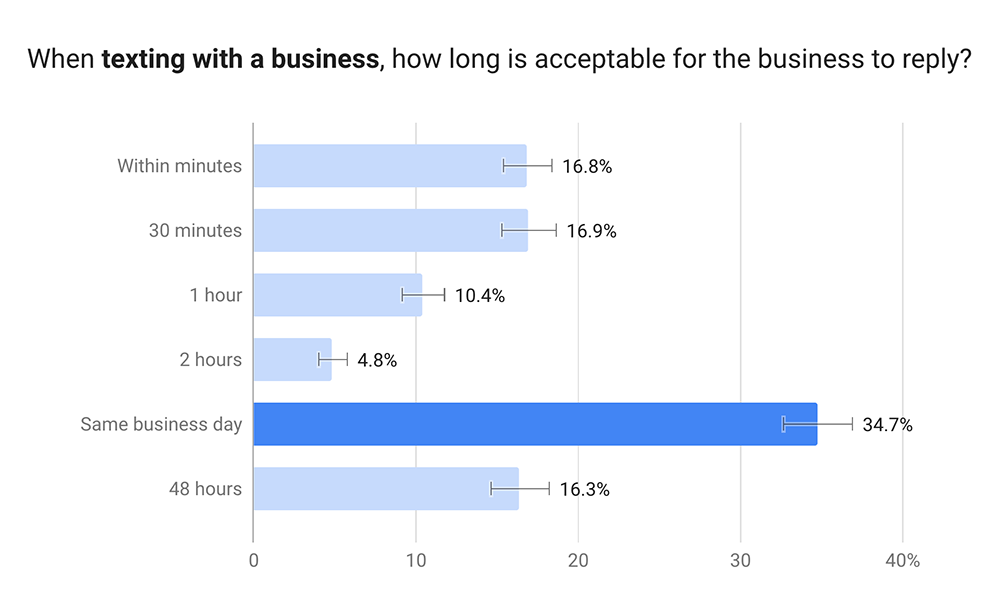SURVEY: Response Times For Text Messages vs. Live Chat
Our survey found most consumers expect a same day reply (34.7%) when texting with a business, but expectations of a reply jump to within a few minutes (50.4%) when using live chat.

Businesses are expanding their communication channels and looking to add real time to communicate faster. For most this becomes a debate between SMS and live chat.
One area in this evaluation for small businesses is to consider the response time expectations of the customer when they engage over these real time channels. We wanted to get answers on this so we ran a survey with 2,000 respondents to understand response time expectations for texting and chatting. Let’s see what we learned.
Same Day Responses Lead For Text Message Replies
Our first survey question asked consumers “When texting with a business, how long is acceptable for the business to reply?”. The top time frame selected in this survey was same day at 34.7%.

18-24 year olds most evenly spread on fast and long text response times
For text message replies, “same business day” was the top choice among all age groups but one. What we found interesting though was that 48 hours was narrowly the top choice for 18-24 year olds in our survey, just ahead of same day. This age group also selected the highest percentage of any age group for “Within minutes”.
- Within minutes – 22.6%
- Same business day – 26.4%
- Within 48 hours – 27.3%
Consumers expect instant replies when using live chat
This shouldn’t be a surprise, but 50.4% of consumers expect an instant reply when using live chat to communicate with a a business. Our survey reinforced that chat is viewed as a “right here, right now” channel for consumers.
What we did find interesting is that the second highest acceptable time frame was a same day response at 25.8%. With how most live chat tools function, this means the consumer either keeps that website and chat window open all day or they are just expecting an email reply when the business responds to their contact.

Expectations of a response within minutes is 3x higher for live chat than text
When comparing our survey results in text messaging replies versus live chat you see that it’s exactly 3 times the number of consumers expecting a reply within minutes for live chat (16.8% for text vs. 50.4% for live chat). These raised expectations are definitely something to be considered if your business is considering live chat or looking at how to best offer a real time channel like chat, messaging or text.
What happens when live chat is offline? It’s not what you want
The last question we asked was to find out how consumers react when finding a live chat tool on a website that is currently offline or not staffed. While some live chat tools are bundled with a service that answers chats 24/7, many are just the tool itself with the need to be staffed by the business. This makes extended coverage times a challenge, most likely leaving your live chat offline to users.

57% of consumers leave your website, only 8% complete the form
For most consumers, being greeted by the news that your instant help is now just a form to get an email is disappointing. This jumped out at us when looking at this survey’s results with over 57% of consumers leaving the website when seeing that live chat is offline or unavailable.
The back-up plan of getting them to full out a form to be contacted by email doesn’t look very promising with only 8.2% willing to do so. 16% were willing to come back to the website later to try to chat again and 13% would close the chat and use another contact method.

These results were an attention grabber for sure. Live chat is a solid real time communication channel, but this points out some decisions a business should consider to make sure chat isn’t a leaky bucket for leads and conversations. Some of these items to consider are:
- What do our consumer expectations and communication times look like?
- Can we staff our live chat extended hours?
- What is the experience when our chat tool is “offline”?
- What are the calls to action when live chat is not available, or doesn’t show on the website?
One of the biggest things to point out here is that when live chat is offline and defaults to a form, it ends up back to an email exchange. This rollback from chat to email defeats the purpose of why the consumer wanted a real time channel to start.
Don't miss leads with live chat. Close more leads faster with text messaging and our web to text widget. Get a demo
2-way text messaging is better for small business
We’ve stated our take on this before, but this data reinforces many points we held on leaning toward text messaging over live chat.
- Text Message expectations for reply time is lower. With over 50% of consumers feeling same day or longer was acceptable for text replies versus 57% of live chat replies within minutes, it’s very different. Consumers seem to be more forgiving on text reply times, thus giving you a better opportunity to exceed their expectations with quick replies.
- Managing text messaging can be easier on your staffing. With the ability to take inbound text messages at anytime and have auto replies outside of business hours that set expectations, you can still get the conversation started.
- Offline live chat tools might lose you leads. As shown above, an offline live chat might be losing leads and contacts. You want a real time solution that gets the conversation started and keeps it in real time, not defaulting back to the slow, static email exchange a consumer is trying to avoid.

Get our monthly update covering SMS, messaging, and Leadferno features.